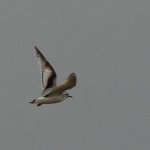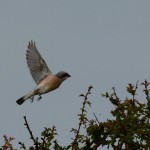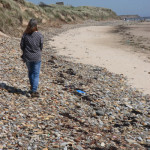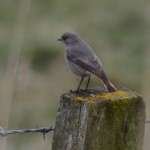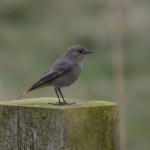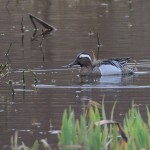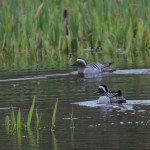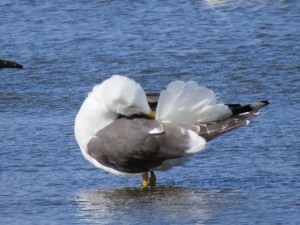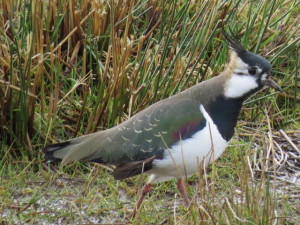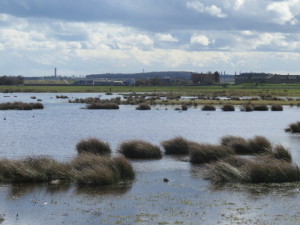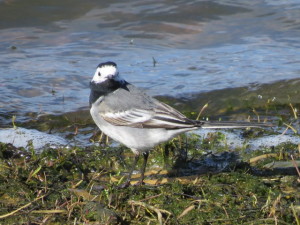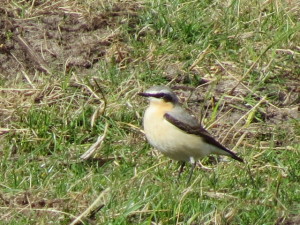Yesterday we covered Druridge Bay with stops at Cresswell & Druridge Pools. Cresswell Pond is now in excellent condition with a large area of sand bank near hide for birds to rest & feed. 11 first-summer Little Gulls were present. Apparently have been up to 16 lately. Also 14 Black-tailed Godwits , a small portion of the 42 seen the previous day and a fine summer-plumaged Grey Plover. The immature Spoonbill is still present spending most time at the northern end. On to Druridge Pools and little new to be seen. The water level has risen considerably with the recent rain so less mud available. Today was spent on Holy Island & two fine male Red-backed Shrikes seen. One was 100 metres East of the Straight Lonnen near the cottage on the Crooked Lonnen. The other was more confiding as it sat in bushes 200 metres S of Snook House. Thinking this might be the one time we get close to a male we were steadily getting nearer without spooking the bird when a Linnet dive-bombed the shrike & it took flight. I take little credit for the flight shot here as it was a complete fluke that I was pressing the shutter at the time ! We spent some time alongside the causeway before we were cut off with close views of a few Dunlin, Ringed Plover, two Grey Plover & a Turnstone. Most in full summer plumage and the Sanderling especially were quite a sight. Short stops at Fenham le Moor, Budle Bay and Hoppen Kiln flash were all fairly quite with only one Black-tailed Godwit at Hoppen Kiln though plenty of water still present. many cute Lapwing chicks here. TRD/JD
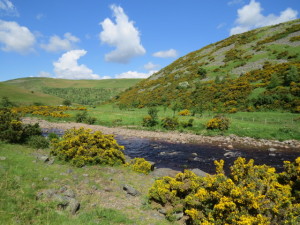
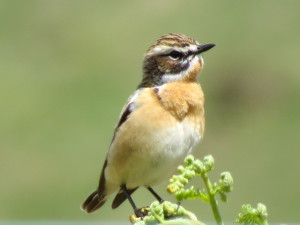
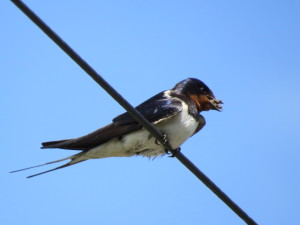
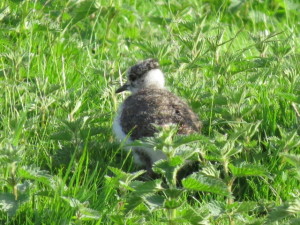
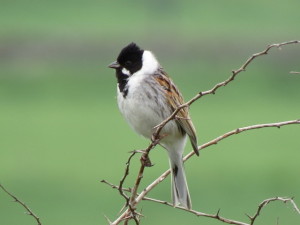 Hard as it is to believe looking at today’s constant gloomy downpour,but a warm,sunny,lovely Northumberland morning found me on monday up in the Ingram Valley once again. I was early enough to be ahead of the lunchtime throng of picnic parties,so had the birdlife to myself. A slow drive into the valley and 4-5 Yellowhammers could be heard and seen singing . Reed Buntings, Willow Warblers and Chiffchaffs also sang as a group of Sand Martins hawked along the Breamish river,some entering bank-side nest holes. On shingle,Oystercatchers,Common Sandpipers and Redshanks had their nests,noisily taking flight at my approach. Heading upstream,Dipper and Grey Wagtail noted and the first of many Whinchats sang from the now growing bracken. A total of 17 of these migrants were seen,a few females,but mostly territorial males. As I watched and photographed a pair,I saw the female dive into a grassy tussock where with careful approach after she flew out,I found a nest with 6 azure blue eggs. Quickly retreating, I watched her return to settle on the nest. 4 Whitethroats sang nearby ,the heathland habitat very different from the local birds in and around my suburban area. 4-5 Common Buzzards could be seen above,hunting the fells and then a female Kestrel appeared “mobbing” a much paler raptor. To my great suprise, it was a Rough legged Buzzard! A rare winter and passage visitor ,not annually seen in the county,this bird , an immature, hovered frequently above of one of the hills,showing it’s main distintive features of white tail with a dark band, black belly,pale head and dark carpal patches. One of the Common Buzzards stooped towards the stranger and it headed off west, upsream. I have seen Rough legged in Spring once before in the county, a very nice suprise once more. Birds of this species have recently been spotted in North Yorkshire and in the Scottish Border country.
Hard as it is to believe looking at today’s constant gloomy downpour,but a warm,sunny,lovely Northumberland morning found me on monday up in the Ingram Valley once again. I was early enough to be ahead of the lunchtime throng of picnic parties,so had the birdlife to myself. A slow drive into the valley and 4-5 Yellowhammers could be heard and seen singing . Reed Buntings, Willow Warblers and Chiffchaffs also sang as a group of Sand Martins hawked along the Breamish river,some entering bank-side nest holes. On shingle,Oystercatchers,Common Sandpipers and Redshanks had their nests,noisily taking flight at my approach. Heading upstream,Dipper and Grey Wagtail noted and the first of many Whinchats sang from the now growing bracken. A total of 17 of these migrants were seen,a few females,but mostly territorial males. As I watched and photographed a pair,I saw the female dive into a grassy tussock where with careful approach after she flew out,I found a nest with 6 azure blue eggs. Quickly retreating, I watched her return to settle on the nest. 4 Whitethroats sang nearby ,the heathland habitat very different from the local birds in and around my suburban area. 4-5 Common Buzzards could be seen above,hunting the fells and then a female Kestrel appeared “mobbing” a much paler raptor. To my great suprise, it was a Rough legged Buzzard! A rare winter and passage visitor ,not annually seen in the county,this bird , an immature, hovered frequently above of one of the hills,showing it’s main distintive features of white tail with a dark band, black belly,pale head and dark carpal patches. One of the Common Buzzards stooped towards the stranger and it headed off west, upsream. I have seen Rough legged in Spring once before in the county, a very nice suprise once more. Birds of this species have recently been spotted in North Yorkshire and in the Scottish Border country.
Moving on reluctantly, I headed west to Holystone ,stopping frequently along the way . At one stop, a pair of Spotted Flycatchers were found, House Martins and Swallows were collecting mud , and a Mistle Thrush fed it’s 2 fledged young. Several singing Skylarks and Meadow Pipits noted too. Yellowhammers and Whitethroats commonly seen and 3 male Redstarts noted. At Holystone woods, no Wood Warblers seen this visit ,but 8 singing male Redstarts was a good count. A Grey Wagtail fed 2 youngsters in,unusually a clear fell area of a conifer wood. Tree Pipit ,Treecreeper ,Nuthatch and Great spotted Woodpecker noted. A calling Cuckoo was immitated and flew towards me to investigate,landing in close view,uttering a chuckling call. Siskins and Redpolls were common here and at nearby Hepple, 5 calling Crossbills seen. Common Sandpiper,Sand Martins and 14 lapwings with young noted along the River Coquet,but sadly a road casualty here was a Lapwing and it’s youngster ,a great shame to see.
A.S.Jack
We carried out a beached bird survey along 1.2 km of Druridge Bay (Northumberland) in very good weather. There were 11 bird finds (including nine new finds). The new finds were mostly remains (not complete corpses) of three pigeons (wood / feral), a puffin, two guillemots, a black-headed gull, herring gull and a song thrush. I collected the complete sternum (breast bone) from a (wood) pigeon, the broken sternum from an adult guillemot and the song thrush wing and bone remains. One of our finds, the right wing remains from a first-year herring gull, was examined and measured indicating a likely male L. a. argenteus bird. Some of the live birds we encountered during our visit were sand martins, a meadow pipit with beak full of food, sandwich tern, black-headed gulls, linnet, whitethroat, blackcap and willow warbler. The photo shows Linda walking the shore of the bay. If anyone would like to find out more about the beached bird project, or become involved, please get in touch. Dan Turner
Out to Druridge Bay for another wander. Druridge Pools was proving popular with the ‘manacled’ Spoonbill showing well from the hide facing south. Why so many rings is beyond me. Also here a drake Garganey was lingering. Plenty of interest here with water levels just right for a variety of species. On to Cresswell Pond and a stop at the causeway where a Wood Sandpiper was showing well. Also here a drake Garganey. On to the hide and pleased to see some mud ! The sand bank on the beach was dug out on Tuesday and water levels have thankfully dropped considerably. Two drake Garganey were on the spit on the west side, quite possibly one of the males seen earlier. Two Common Terns were outside the hide with Reed Warbler singing well there. TRD/JD
The last day of no artillery firing during the lambing season, saw me taking the chance to head up to the Otterburn Army Ranges, the wildest,most remote area of the county. Here the vast upland fells hold a good variety of bird species ,with some like Skylark and Meadow Pipit breeding in large numbers. As I travelled through the area at least 50 -60 of the former created a constant background of song with many more seen on or near the ground. Pipits were displaying in many areas too. Near Alwinton,another upland species was present in very good numbers with 9 singing Whinchats noted in only a single kilometre stretch of moorland ,with more seen in other areas. 2 Cuckoos called from streamside trees, one then mobbed by Pipits. A Buzzard ,Sparrowhawk and Kestrel were the only raptors noted. Along the river Common Sandpipers lived up to their name,with 7 seen in one valley. Dippers nest under the many river bridges here and several , including newly fledged youngsters were seen, along with Grey and Pied Wagtails.A single Ring Ousel sang from high in one rocky gully and a flock of Common Gulls moved through Coquetdale. Wheatears were noted in several places,as were Reed Buntings,with 11 males seen. This being a species which breeds throughout the county in a wide variety of areas. A single Spotted Flycatcher was heard,then seen, newly arrived from Africa. House Martins had also returned ,with Swallows and Sand Martins to the upland valleys , some nesting at the most remote farms . Along the Coquet, birds included several Gooseanders, Oystercatchers and Redshank, with a few Lapwings, Curlew and Snipe displaying , though in far smaller numbers than in the south west of the county. At Holystone, Tree Pipits were songflighting , with several noted among the many singing Willow Warblers. Here too were Redstart,Nuthatch and Treecreeper , Goldcrest, Siskin and Redpoll.
Returning via Caistron,which held Great crested and Little Grebes, Shelduck and Gooseander.Then over Simonside with Yellowhammers,Tree Pipit and more Skylarks,then another Cuckoo and Whinchat,Redstart and Red Grouse and a pair of Spotted Flycatchers to round off a superb day.
A.S.Jack
Today we decided to drive up to Beadnell, in the hope of catching up with a Lesser Yellowlegs, which had been sighted 1 mile SSW of Beadnell over the past couple of days. We parked at the pay and display car park (parking meter was covered and it said free today). We then travelled SW through the nearby caravan park, for about 10 mins, then continued on a path, with the dunes to our left for about another 10 mins. We located the bird in a flooded field to the right. We were unlucky to get drenched a couple of times in the heavy rain showers, however we didn’t mind as we enjoyed good views of the Lesser Yellowlegs.
After a short stop in Seahouses, to dry off and enjoy some fish and chips, we moved onto Hoppen Kiln Flash (which is close to Hoppen Kiln Farm, Bamburgh). Here we very quickly located five Garganey (one more than we’d heard were present), including one attractive male, a Wood Sandpiper and a handsome Pectoral Sandpiper.
We also found a male Shoveler, 4 Shelducks and there were lots of singing Warblers, which included Sedge, Blackcap, Willow, Chiffchaff and Whitethroats.
We also recorded our first Swifts of the year (rather late for us), as two briefly passed through.
Paul & Adriana Buskin
Up early in anticipation! Pleased to see yesterday’s find was still present, a fine female Woodchat Shrike at end of hedgerow half way between Druridge & Hemscott Hill farm. Seeing as this is the first multi-observed bird in the county since the late 1990’s it must have proved very popular yesterday. We were meanwhile having a late afternoon wander around Caistron where a Wood Sandpiper seemed lesser fare to the text staring at me on my phone. Still for once the bird does the decent thing and stayed with distant views obtained and many happy birders, apparently still present in evening. Nine Swift went through north whilst there after our first for the year yesterday in Rothbury. Other sites seemed quiet with water level too high again at Cresswell. Druridge Pools is still hosting the Great White Egret though and good views obtained in flight & on the ground. 36 Whimbrel here in a one flock were impressive though apparently up to 95 seen recently here. Habitat still superb for spring waders. Lunch at Widdrington Inn and afternoon at East Chevington. Four Grasshopper Wablers reeling and one seen well with two Reed Warblers in now on South Pool. Plenty of other warblers and 25 Common Terns feeding. TRD/JD
Started the day early at Whittle Dene, a May frost covered the ground but soon melted away as the sun came up. A Common Tern left it’s roost and began to fish, Sand Martins and Swallows hawked over the glass-like lakes and Sedge Warblers and Whitethroats sang. Great crested Grebe, Teal, Shelduck and Wigeon were among the wildfowl noted. Roadside hedgerows held 7-8 singing Yellowhammers and several Skylarks were heard above.
Arriving later at forest/moorland near Blanchland,a Cuckoo called and 2 Tree Pipits noted. Siskin, Redpoll ,Song and Mistle Thrushes and several Red Grouse seen. On the moors, the breeding wader population remains very healthy, with many pairs of Lapwings with eggs or small young and much display. Also displaying were Golden Plover,Curlew,Snipe and Redshank. Skylarks here too.
At Derwent Reservoir, Redstart, Common Sandpiper and Cuckoo were among the birds seen. Many Red Grouse, Meadow Pipits, Wheatears ,Curlew and a Ring Ousel noted near the county boundary with Durham. A male Black Grouse seen at Rookhope with more Reds.
Into Allendale, and more Wheatears perched on roadside walls withMeadow Pipits and Pied Wagtails common. Breeding waders were again much in evidence,with at least 90 -100 pairs of nesting/displaying Lapwings present, youngsters again noted. Curlews, Snipe, and Redshank all displayed here. More Red Grouse seen too. A Buzzard circled, being mobbed by Lapwings. Dippers nesting under a bridge.On down to Allenbanks, where a riverside ,woodland walk revealed 4 singing Pied Flycatchers and a single Wood Warbler and Redstart. 3 Grey Wagtails and 2 Dippers. Finally, up to Grindon where another Cuckoo called and a summer plumage Dunlin probed the lough-side mud. Swallows and Sand Martins here low over the water in the cool conditions.
A.S.Jack
The 28th, and the Whitley Bay cemetery Wryneck obliged for it’s 3rd day, showing very well to the assembled crowd at close range as it sought ants between the gravestones. Another was found later down at St. Mary’s Wetland, at first seen in bushes among the reedbed. A Whinchat, Lesser Whitethroat and 5 singing Whitethroats, 17 Reed Buntings and 2 Sedge Warblers made for a good session. A few Sanderling remained on the beach.
29th- peering through very thick morning fog for a reported Pied Flycatcher at Tynemouth drew a blank,however I heard a calling Redstart and managed to locate it west of Collingwood’s Monument. A splendid gaudy male,watched before it fled before 3 dogs.
Later in now warm sunshine , saw me up at Beacon Hill ,a long-time favourite spot in Spring and Summer . I recently dug out some ‘photos of me there with binoculars,with my parents in 1964! 3 singing Redstarts, a Tree Pipit and Cuckoo were excellent. 10 Redpolls ( in pairs), were singing/displaying, as were 20+ Willow Warblers. Other notable species included 2 pairs of Bullfinch, 12 Chiffchaffs, Nuthatch, Skylark,Treecreeper,Swallow,G.S.Woodpecker,Yellowhammer, Linnet,WillowTit and Jay.
Onward,and another Redstart at Blackpool Farm. Willow Warblers singing at every stop and many heard from the car. At Wingates, no less than 8 displaying Tree Pipits seen in an area of young trees,fantastic! Whitethroats too were very common in this area. Then 3 Buzzards took to the air from an older wood,calling. A second Cuckoo of the day also called,but was not seen. 2 more Redstarts spotted and suprisingly a pair of Lapwings had taken up residence on the ground flattened to accommodate wind turbines here- much display from the male,but sadly no rivals to impress from this much declined species in this area. A Green Woodpecker was glimpsed,then a “year tick” in the form of a singing Garden Warbler.More Redpolls here too.
A.S.Jack
Whitley Bay Cemetery
Not far from the ‘Chapel’, it was easy to obtain excellent views of a Wryneck, which has been present over the past few days. Over the years I’ve always enjoyed the cemeteries visiting birds especially the Black Redstarts.
St Mary’s
Close to the ‘Wetland’, a Grasshopper Warbler was reeling. Nearby there were Chiffchaffs, Willow Warblers, Sedge Warblers, Whitethroats and a Blackcap. Close to the cliffs over a dozen Sand Martins were feeding, whilst a group of 10 Sanderlings rested below. There was no sign of any Sandwich Terns. Skylarks, Meadow Pipits, Reed Buntings and Linnets were out in good numbers.
Paul Buskin
Along the coastline between Lynemouth and Druridge I counted 53 Wheatears in small feeding parties, with some of the males in song. Also at St. Mary’s 14 seen on the 23rd and 20 yesterday. A nice arrival .
At Woodhorn, a singing Sedge Warbler and Whitethroat, and another Sedge Warbler at Cresswell. Here too was a pair of Stonechats,with another pair at Druridge and 3 Yellow Wagtails near Cresswell. Grasshopper Warblers seen and heard at Cresswell, Druridge and 3 at St Mary’s. Many pairs of Swallows seen back at nest sites and Sand Martins noted in good numbers. Spotted Redshank and Greenshank at Cresswell in the afternoon.
Inland next, and 3 Redstarts in song near Morpeth.
A.S.Jack
Excellent spell at Druridge Bay today. Started at East Stobswood Pool with 6 Whimbrel feeding in field. No sign of Green-winged Teal seen recently there. On to Druridge Pools and first Grasshopper Warbler & Sedge Warbler of the year. In with the Curlew were up to 20 Whimbrel, unfortunately not counted accurately as a small plane put them all up. Pools still look fine though water level now needs to drop a little for waders. Cresswell Pond had a fine summer plumaged Spotted Redshank on sand bank outside hide. Also Greenshank briefly before it flew off. Finally East Chevington with 8 Common Terns on islands, 12 Red-breasted Mergansers, the summer plumaged Black-necked Grebe and surprisingly five pairs of Great Crested Grebes. Whilst there the Greenshank presumably from Cresswell flew over North. Also Whitethroat today at Druridge & Cresswell. TRD/JD
This week a noticable incoming of our Spring migrant birds has been taking place. Tuesday 15th,at Arcot and 3 Willow Warblers and 5 chiffchaffs were in song , and a Grasshopper Warbler reeled in constant view from a sparsely leafed bush. A Green woodpecker called loudly from the distant woods . I was back there on the 19th ,and a pair of House Martins and a Swallow hawked above the pond. Willow Warbler numbers had increased to 8 and 2 Blackcaps sang.The Green Woodpecker was now yaffling in plain view from a dead tree.
At St. Mary’s this week 1-2 Grasshopper Warblers were in and Willow Warblers and Chiffchaffs were passing through. 6 Skylarks were singing and a total of 11 male Reed buntings was a good count,as they establish territories. At Beacon Hill on the 15th, my first Redstart of the year,with a superb male heard calling,then seen as he began singing. Here 12 Willow Warblers were in song in between foraging for insects and 10 Chiffchaffs noted with 4 Blackcaps,Swallow and Willow Tit. Back here on the 19th, and a cool,bright morning had seen an increase in Willow Warbler numbers to 20+, a couple of pairs already inspecting potential nesting sites on the ground. The Redstart count doubled ,with another splendid male seen well.Among the resident birds, were 2 Willow Tits, 5 Yellowhammer males, 6 singing Skylarks,3 Buzzards , a few Redpolls and Linnets, singing Nuthatches and Treecreepers. Then a Tree Pipit sang from a heath and was seen well-another year first!
On up to Branton and 3 House Martins seen from the car, as Swallows were back at all the farms I passed. Sand Martins now in good numbers with 20 at Branton and a further 30 upstream from here. 20 singing Willow Warblers noted here and 5-6 Redpolls. A Great crested Grebe was on the open water and the Black headed gull colony was in full swing. 7 Yellowhammers noted here too. Into the Ingram valley and 5 newly arrived Common Sandpipers noisily sparred for riverside territories. Yet more Willow Warblers noted here -nice to see them still so abundant. Oystercatcher, Redshank and Ringed Plover noted in the valley. In one flowering tree, a dozen Peacock butterflies and 9 Tortoiseshells fed in the sun.
Up to Harthope next, where a pair of Dippers and Grey Wagtails were photographed as they fed young. 8 Song Thrushes counted , including a pair feeding young. Again, Willow Warblers and Chiffchaffs back in force -my day total for both topped 100 each. Red Grouse called from the hillsides and then another year first in the shape of 5 Ring Ousels seen in one area, 3 of which were together( 2 females). 2 male Wheatears, Grey Wagtail, another Dipper, Redpolls and Meadow Pipits and Skylarks also seen.
At one site today in the south east a pair of Ringed Plover were nesting,then a splendid Little ringed Plover was spotted very close to me. It then began calling on the ground and took off to perform it’s display flight,calling as it circled above. The object of his display was spotted , as his mate crouched not 20 yards from me! I quietly backed away to leave them in peace. I heard of another pair at a different site too today.
Along the old waggonways to Holywell, nice views were had this week of a singing Lesser Whitethroat and then my first Whitethroat of the Spring both on the 18th. Here a dozen Willow Warblers and Chiffchaffs were in, as were 7-8 Blackcaps.
A.S.Jack.
A look at Newton today starting at the scrape N of Newton Pool. Gary Woodburn’s efforts to keep this in ideal condition have paid off with two Ruff at present. Always a difficult bird to see in Spring and only my second ever April sighting in the county. Plenty of scope for Spring waders here. An early House Martin was over the scrapes with Sand Martins. On to the Long Nanny and a Little Egret in the channel. Further North between the bridge and Beadnell the scrape is also in good condition with one Ruff there (probably moved up from Newton) and a fine male Yellow Wagtail plus three more Wheatears. Quiet otherwise with gale at times ! TRD
Osprey flew past the house at 19.20hrs this evening (6th April) following the South Tyne West Stewart J Hingston
Out to Druridge Bay area today starting at East Chevington. At the N end of N Pool at 10:10 I noticed that all the gulls had suddenly got up from the islands and hence scoured the sky. Picked up a large bird of prey and was pleasantly surprised to see it was a Red Kite ! Only the second coastal record for me in the county. Janet picked it up too and obtained a ‘blob’ pic on her Bridge camera. I was meanwhile scoping it to see if there were any wing tags and none seen. Views were excellent in the scope & tags would have been seen if present. Cannot though be claimed as a continental migrant as not all the young kites from the Derwent Valley in recent years have been tagged. Also had the male Marsh Harrier, almost summer-plumaged Red-necked Grebe, Peregrine and three Long-tailed Duck. I gather the Black-throated Diver was also present later on. Singing Willow Warbler (our first this year) at Druridge Bay CP. On to the Drift Cafe at Cresswell for a welcome cuppa (Newly opened between Cresswell village & Cresswell Pond). Cresswell Pond had five Black-tailed Godwit and two Sand Martin plus a smart second-summer Mediterranean Gull with a full hood. Also a look at Druridge Pools and Shoveler numbers now well down but the male & female Pintail still present and a Ruff reported apparently. TRD/JD
Yesterday we covered Druridge & Cresswell Pond and had luck with the Black Redstart as managed to scope it distantly N of the turning circle at Druridge. Ended up photographing it half way to East Chevington ! Plenty of interest from the Budge screen at Druridge as now 42 Shoveler which I make a record count for Northumberland since 50 at Swallow Pond in October 2007. Also eight Black-tailed Godwit there which flew off N. Druridge Pools is in excellent condition & looks very hopeful for the Spring. On to Cresswell Pond and pleased to see the sand bar has now been dug out so water level down. A pair of Pintail there and plenty of common waders. On the way back to Rothbury we had our first Little Owl of the year. Today we ventured out to Buston Links as a drake Garganey had been reported. Taking the very rough track (borderline accessible in a saloon!) down to the car park by the dunes S of Alnmouth we walked half a mile S to view the small pools and success. Not one but two drakes and reasonably close to the coastal track. Also in the fields here were 5 Whooper Swans and a Sand Martin moved N. TRD/JD
Today, we got up early and drove an hour and half up to Holy Island to share the day with other bird club members for the spring field trip. At the causeway there were two Long-tailed Ducks, near the hut with several Shelduck. The weather was foggy and cloudy, with temperatures between 5-7c. Highlights for us included a shy female Black Redstart, which is always a welcome addition to our year list.
It was nice to see Bar-tailed Godwits with some Knot at St Cuthberts Island. Nearby there were 2 Slavonian Grebes in their attractive summer plumage and a group of six Long-tailed Ducks. Meadow Pipits and Skylarks were out in good numbers. Two Grey Herons and a Fieldfare were spotted, which are birds; we have not recorded as frequently this year
We didn’t see any butterflies, however there were up to seven Roe Deer and as always lots of Grey Seals. Spring visitors included two Chiffchaffs.
At the Lough, three handsome Reed Buntings were showing off there summer plumage in front of the bird hide. On the water there were three Goldeneyes. Little Grebes could also be heard calling. Finally as our day was coming to an end, a Short eared Owl put in an appearance, which was much appreciated, especially as there has not been as many around this winter.
A great day out. Lots of exercise and a good variety of wildlife.
Adriana & Paul Buskin
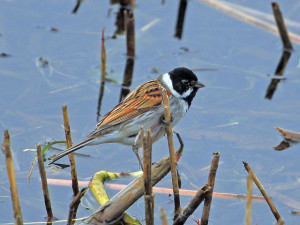
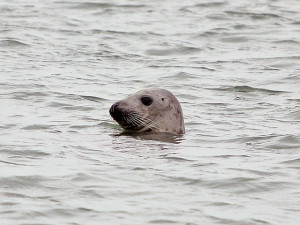
Spent a few hours in the East Allen valley this afternoon. Rather windy (Easterly) conditions bright at first though cold clouding over later with wintry showers. Waders very prominent with all the commoner species now displaying on territory and groups of Curlew, Lapwing and of course Golden Plover the latter in some very large groups in the usual spring gathering areas. Highlights included 13 male Blackcock in the usual field at Swinhope Shield 5 of which formed a circle and started lekking. Sipton Burn came up trumps with 2 Northern Wheatears both males, displaying Meadow Pipits, and a single Sand Martin flew over (all observations from the road bridge over the burn). Then a distinctive burst of song had me looking at a male Ring Ousel perched on the dry stone wall near the burn. As I left a Raven cronked overhead flying off to the SW. On route home stopped off for a walk along minor road near the Coanwood Burn, several groups of Lapwing, Curlew, Golden Plover and a party of 15 Redshank in roadside fields along with a large flock of 247 Fieldfare. 2 Blackcocks showed well in the usual field. As ever Snipe delighted with their drumming overhead. Stewart Hingston
Holywell Dene this morning and 6 Chiffchaffs seen, 3 singing and 3 quietly foraging at ground level for food. The rookery was in full swing,with around 40 nests being repaired for the new season. A pair of Dippers were nestbuilding under a bridge and a Great Spot. was drumming above. 4-5 Skylarks singing in the surrounding fields and a noticable influx of Meadow Pipits. A L.B.B. Gull preened at the pond and a few Little Grebes noted here.Up to Newbiggin where 22 Common Scoter loafed in the bay and 5 Med. gulls counted.
On up to Druridge Bay and a search of the links and dunes for any incoming Wheatears. A male found near the north car park at Cresswell was nice to see,and a mini-twitch ensued as passing birders stopped to see what I was looking at! 5 Twite noted nearby , one of which was singing in flight. A White Wagtail with 2 Pieds was my year’s first,followed by 2 more near Bell’s Farm,then a 4th at Druridge Pools. Here, the Common Scoter remained. A Chiffchaff sang here too as did the male of a pair of Stonechats,while his mate gathered nest material. From the Budge screen many Lapwings displayed as did a few Snipe and Redshanks. Shoveler,Gadwall and Teal here in good numbers. A Sparrowhawk soared over the distant conifer belt. I was told a single Sand Martin had been seen at East Chevington and the Black throated Diver was still present.
Sunday 23rd and 70 Whooper Swans flying north , low over the sea at Whitley Bay.
A.S.Jack
Chiff Chaff singing behind house last 5 days not a breeding site! (nr Haltwhistle) another at Grindon Lough (wood at side of road) Northern Wheatear at Sipton Burn (East Allen) this afternoon no sign of any Ring Ousels yet. Golden Plover flocks starting to build up in traditional sites again in East Allen valley extensive black on males suggesting Northern race, Redshank Snipe and Oystercatcher also back on their upland breeding sites and displaying. Quite a few Fieldfare groups in area this last week some in the hundreds.
Good birding All
Stewart Hingston
During a relaxing walk through the Parks and Dene in Wallsend, we were surprised to discover an adventurous young Grey Squirrel, not far from the resident Stock Doves. There were also at least five singing Chiffchaffs.
The refurbished pond looked much better, with even the Mallards, looking smarter and happier. The water was still a little stinky in places however.
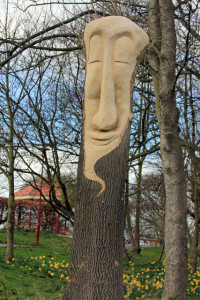
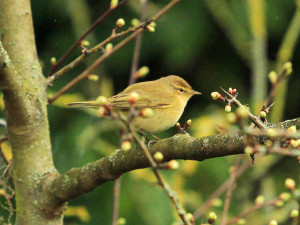
Paul & Adriana Buskin
A bright March morning saw me in the south west of the county, where Spring seems to have arrived, with temperatures reaching a dizzy 15 degrees. Many waders have returned to their upland breeding grounds, some 4-5 weeks earlier than last year. The most numerous were Lapwings, with a flock of 60 together in a field,but many more than this were attempting to establish breeding territories and attract mates with display flights and constant calling. In 3 hours there was never a spell when I could not hear several calling birds. At least 80-90 pairs were becoming established, with unattached males vying for the attention of females,whose partners would drive them off. Males were “up-ending” at potential nest-scrapes showing off their red undertails. Great to see such a healthy population in a declining species over much of the county. Also in the air, display-flighting, were around 30 Curlews , 12 Snipe and 20 Redshanks,while others were seen on the ground and on walls. Meadow Pipits and Skylarks were also much in evidence,though many of the former have yet to return from wintering grounds, numbers being quite low as yet.
As I enjoyed the spectacle,a familiar,distant croak was heard and a pair of Ravens flew in from the higher tops, to land among the sheep on the lower fields,causing panic among the waders. Other birds noted, included several Mistle Thrushes, Siskins, Pied Wagtails, Goldcrests and Chaffinches. Moving on to higher moorland, Red Grouse appeared common with at least 30 being seen, again engaged in courtship activity. 2 female Black Grouse were the only ones noted today. A great spectacle then came in the form of a huge flock of feeding Starlings, around 5,000 I thought,carpeting the fell as they fed ,then rising into the air,forming ariel patterns and darkening the blue sky, before turning to drop again to the ground.
Comma and Tortoishell butterflies added to the Spring feel.
A real pleasure to be out here on such a good day!
A.S.Jack.
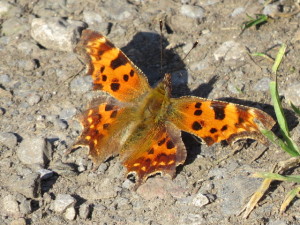
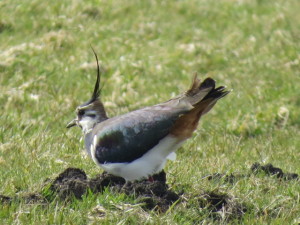
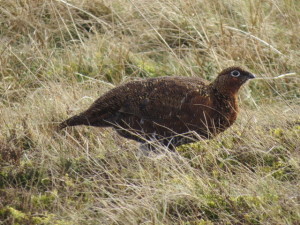
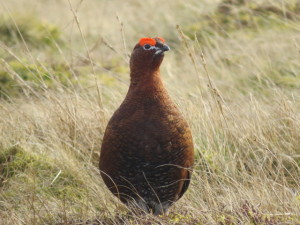
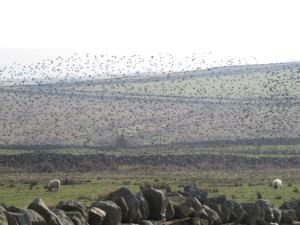
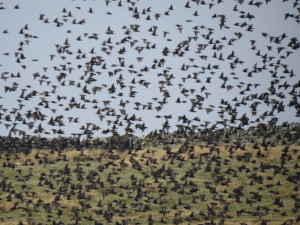
Spent a very rewarding 90 minutes late afternoon today in the Coanwood Burn / Coldshield area (NY7258) Waders now well established on territory with Lapwing and Curlew displaying everywhere along with a single pair of Oystercatchers and several single Redshanks. Good numbers of Snipe “drumming” I had 7 around me at one point. A mobile flock of 61 Golden Plover present on the moor many of the males showing extensive black suggesting Northern birds. Further on a single bird watched displaying with that distinctive stiff winged flight and that hauntingly beautiful display call (one of my favourite sounds of spring). A male Grey Wagtail foraged along burn sides along with 3 Pied Wagtails. A single Northern Wheatear was a nice surprise perched on a fencepost. On a thin strip of grassy field 3 Blackcock and a single Greyhen were feeding. Red Grouse were very vocal with a lot of display observed. In a field next to Coldshield farm 1000+ Starlings and 340 (ish) Fieldfare foraged.
Stewart J Hingston
Here is a message in a good cause. Apologies if you have already received this. Bird life International has sent some information regarding Diclofenac being available in the European Union. Diclofenac is a powerful anti-inflammatory drug that has wiped out vulture populations in India, Pakistan and Nepal. Now, a repeat of this ecological disaster is threatening Europe. Could you please sign my petition I’ve started and please forward this e mail to as many as friends as possible and get others to sign. Please join this campaign: http://chn.ge/1fHij71 Here is the article from Birdlife International. 03/05/2014 Vulture killing drug now available on EU market
Long day out in the north. Started at Fenham le Moor and on to Holy Island causeway and Berwick. Fenham was quiet as was the causeway & Berwick though we did both manage some decent Rock Pipit photos. Back down and lunch at Barn at Beal ( I should get commission from this place!). Beal Pt served up an excellent female Merlin hunting over the flats. On to Harper’s Heugh where the geese flock can be viewed. 25 Barnacle & three Pale-bellied Brents in with the Greylags & Pinkfeet. Down to Budle Bay and little of note other than the returning Lesser-black-backed gulls with 15 now present. Stag Rocks presented the Red-necked Grebe yet again with a few Common Scoter. Little else noted at Monk’s House or Seahouses. TRD/JD

